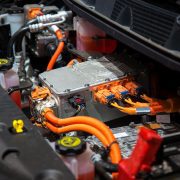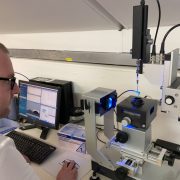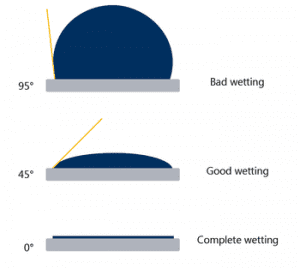 We provide contact angle, wettability and surface free energy measurements of membrane electrode assemblies (MEA) and substrates for proton exchange membrane (PEM) fuel cell technologies, where effective interfacial contact between electrode materials and membrane is necessary for efficient performance.
We provide contact angle, wettability and surface free energy measurements of membrane electrode assemblies (MEA) and substrates for proton exchange membrane (PEM) fuel cell technologies, where effective interfacial contact between electrode materials and membrane is necessary for efficient performance.
Our lab is equipped with a variety of specialist equipment including drop shape analysers, rheometers, and other highly sensitive and versatile physical characterisation equipment.
If you would like to discuss how we could help you with characterisation of the surface free energy for your fuel cells, then please feel welcome to get in touch.
Arrange a virtual tour with one of our team to learn about our capabilities and how we can help you
 One of the major challenges in developing efficient fuel cell technology arises in improving the contact surface area between conducting materials, typically an anode/cathode and electrolyte solution.
One of the major challenges in developing efficient fuel cell technology arises in improving the contact surface area between conducting materials, typically an anode/cathode and electrolyte solution.
Contact angle measurements are used to quantify the wettability of a fluid onto a substrate. A single wavelength backlight is used to cast a silhouette of a droplet on a surface into a camera. Computer software then attempts to fit a line to the shape of the droplet.
High contact angles indicate poor wettability and indicates low preference of interaction between the fluid and substrate under those conditions. Temperature, electrostatics, and inherent material properties all influence the contact angle and degree of wettability of the fuel cell.
 By measuring the contact angle of a ‘known’ liquid on the surface of an unknown fuel cell substrate, we can work out the surface free energy and interfacial tension.
By measuring the contact angle of a ‘known’ liquid on the surface of an unknown fuel cell substrate, we can work out the surface free energy and interfacial tension.
Surface free energy can be thought of generally as the energy a solid surface can provide to a wetting liquid to increase the contact area of the liquid to the solid surface. Higher values of surface free energy generally contribute to better wetting, but polarity of the liquid can also have an effect.
In addition to measuring the surface free energy of a fuel cell, it can be of interest to quantify the ‘polar’ and ‘disperse’ components and identify preferential wetting behaviour for polar and non-polar liquids. This is simply done by comparing the wetting behaviour of a polar and non-polar liquid on the fuel cell substrate of interest.
